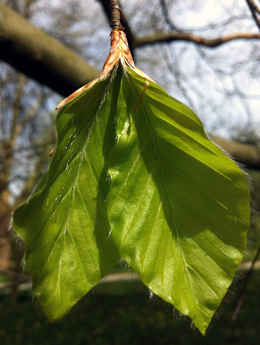Leafing out and climate change

Global warming is generally expected to bring spring forward but, as a new LMU study shows, a concomitant influx of plant species from warmer southern latitudes could counteract this effect.
Climate change is already clearly discernible in our part of the world. Data from local weather stations indicate that the average temperature in the Munich region has risen by 1.5°C over the past century. LMU biologist Professor Susanne Renner and her research group have now looked at the effects of this warming trend on the timing of leaf emergence ("leaf-out") in a broad range of shrubs and trees.
The inducers of leaf-out
"It is widely believed that warmer temperatures will extend the growing season and that leaf-out in our flora will occur at progressively earlier times in the year. However, whether air temperature or day-length is the dominant factor determining the date of leaf-out is actually known for very few of the thousands of species of trees and shrubs," says Renner. As Director of Munich's Botanic Garden, she was in a position to remedy this situation.
Some 16,000 plant species from diverse climate zones are cultivated in the Garden, and Renner and her doctoral student Constantin Zohner have taken advantage of this unique resource to monitor the timing of leaf-out in nearly 500 different species of woody plants. "Such a comprehensive phenological study has never been undertaken before," says Renner. Temperature and day-length are the primary triggers of leaf development, and selective forces during the course of evolution have determined which signal is actually used in a given species. The results of the new study show that, in many woody plants that thrive in warmer southern climes, day-length acts as a safety barrier so that these trees don't risk having their leaves damaged by late frosts – and increased temperature does not override this barrier.
Beech requires long days
This strategy is the better bet for thermophilic species because they are unable to cope with frost damage and are therefore susceptible to late frosts. "This evolutionary adaptation is particularly striking in the case of beech trees, in which leaf-out occurs relatively late in the year," Renner adds. "The beech in Central Europe is a relic of the warmer temperatures that prevailed during the Tertiary Period; leaf emergence requires 13 hours of daylight, regardless of whether the spring was warm or cool and moist."
"Southern species develop their first leaves up to a month later than plants from our temperate climate," says Renner, "and the more of these thermophilic species expand their range northwards as temperatures rise, the more late flushers we may gain. Moreover, species that are already adapted to our northerly climates are unlikely to undergo leaf-out at ever earlier times, because they require prior exposure to a certain number of chilly days to prime the process.
More information: "Common garden comparison of the leaf-out phenology of woody species from different native climates, combined with herbarium records, forecasts long-term change" Constantin M. Zohner andSusanne S. Renner. Ecology Letters (2014). DOI: 10.1111/ele.12308
Journal information: Ecology Letters
Provided by Ludwig Maximilian University of Munich


















